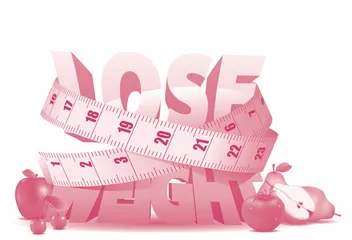Where Fat Goes When You Lose Weight减肥后脂肪去哪儿了
作者: 鲁宾·米尔曼 安德鲁·布朗 左自强译

The world is obsessed with fad1 diets and weight loss, yet few of us know how a kilogram of fat actually vanishes off the scales.
全世界的人都热衷于风行一时的节食法和减肥,但没有多少人知道每公斤脂肪到底是如何从身上减掉的。
Even the 150 doctors, dietitians and personal trainers we surveyed shared this surprising gap in their health literacy. The most common misconception by far, was that fat is converted to energy. The problem with this theory is that it violates the law of conservation of matter2, which all chemical reactions obey.
令人惊讶的是,连参与我们调研的150名医生、营养师和私人教练对健康的认知也存在误区。最常见的误解便是,脂肪都转化成了能量。这一看法的问题在于,它违反了所有化学反应都须遵循的物质守恒定律。
Some respondents thought fat turns into muscle, which is impossible, and others assumed it escapes via the colon. Only three of our respondents gave the right answer, which means 98% of the health professionals in our survey could not explain how weight loss works.
有些受访者认为,脂肪转化成了肌肉,这是不可能的。还有些人认为,脂肪通过结肠排出了体外。只有三位受访者给出了正确的答案。这就是说,参与我们调研的健康专家中,98%的人解释不清脂肪是怎么减掉的。
So if not energy, muscles or the loo, where does fat go?
如果不是转化成了能量或肌肉,也没有排出体外,那脂肪去哪儿了?
The enlightening facts about fat metabolism
“脂肪代谢”给出了答案
The correct answer is that fat is converted to carbon dioxide and water. You exhale the carbon dioxide and the water mixes into your circulation until it’s lost as urine or sweat.
正确的答案是,脂肪转化成了二氧化碳和水。二氧化碳呼出体外,水则混入人体循环系统,最终以尿液或汗水的形式排出。
If you lose 10 pounds of fat, precisely 8.4 pounds comes out through your lungs and the remaining 1.6 pounds turns into water. In other words, nearly all the weight we lose is exhaled.
如果减掉的脂肪为10磅,准确地说,8.4磅是通过肺部排掉的,剩下的1.6磅变成了水。换句话说,我们减掉的体重几乎都是通过呼吸排掉的。
This surprises just about everyone, but actually, almost everything we eat comes back out via the lungs. Every carbohydrate you digest and nearly all the fats are converted to carbon dioxide and water. The same goes for alcohol.
这大概会让所有人都大为惊讶,但事实上,我们吃的几乎所有东西最终都是通过肺部排出的。人体消化的各种碳水化合物和几乎所有的脂肪都转化成了二氧化碳和水。酒精也是如此。
Protein shares the same fate, except for the small part that turns into urea and other solids, which you excrete as urine.
蛋白质也基本一样,只有一小部分会转化成尿素和其他固体物质,以尿液的形式排出体外。
The only thing in food that makes it to your colon undigested and intact is dietary fibre (think corn). Everything else you swallow is absorbed into your bloodstream and organs and, after that, it’s not going anywhere until you’ve vaporised it.
食物中唯一可以不经消化、原样进入结肠的东西就是膳食纤维(比如玉米)。吃下的其他东西都会被吸收进血液和器官,之后,哪儿也不会去,直到被蒸发掉。
Kilograms in versus kilograms out
进出平衡
We all learn that “energy in equals energy out” in high school. But energy is a notoriously confusing concept, even among health professionals and scientists who study obesity.
我们都在高中学过“能量守恒”的知识。但能量是一个极其令人困惑的概念,连一些健康专家和研究肥胖问题的学者也搞不清楚。
The reason we gain or lose weight is much less mysterious if we keep track of all the kilograms, too, not just those enigmatic kilojoules or calories.
如果我们跟踪记录下所有摄入的食物量,而不仅仅纠结于那些难以捉摸的千焦或热卡,那么体重增减的原因就远没有那么神秘了。
According to the latest government figures, Americans consume 3.55 kg (125 ounces) of food and beverages every day. Of that, 430 grams (about 15 ounces) is solid macronutrients, 17 grams (0.6 ounces) is fibre and the remaining 3.11 kg (110 ounces) is water.
政府最新公布的数据表明,美国人每天消耗的食物和饮料为3.55千克(125盎司)。其中,430克(约15盎司)为固体宏量营养素,17克(0.6盎司)是纤维,其余3.11千克(110盎司)是水。
What’s not reported is that we inhale more than 660 grams (23 ounces) worth of oxygen, too, and this figure is equally important for your waistline.
没有提到的是,我们还吸入了超过660克(23盎司)的氧气,这个数字对你的腰围同样重要。
If you put 3.55 kg (125 ounces) of food and water into your body, plus 660 grams of oxygen (23 ounces), then 4.2 kg (148 ounces) of stuff needs to come back out, or you’ll gain weight. If you’re hoping to shed some weight, more than 4.1kg will have to go.
如果摄入体内的食物和水为3.55千克(125盎司),再加上660克(23盎司)氧气,那么需要排出体外的物质应该是4.2千克(148盎司),否则体重就增加了。如果想减肥,那必须排掉4.1千克以上的东西。
The 430 grams (15.2 ounces) of carbohydrates, fats, protein and alcohol most Americans eat every day will produce exactly 770 grams (27.1 ounces) of carbon dioxide plus 290 grams (10.2 ounces) of water (about one cup) and about 31 grams (1.1 ounces) of urea and other solids excreted as urine.
大多数美国人每天摄入的碳水化合物、脂肪、蛋白质和酒精为430克(15.2盎司),刚好产生770克(27.1盎司)二氧化碳及290克(10.2盎司)水(约一杯),还有约31克(1.1盎司)以尿液形式排掉的尿素及其他固体物质。
An average 75kg (165 pounds) person’s resting metabolic rate (the rate at which the body uses energy when the person isn’t moving) produces about 590 grams (21 ounces) of carbon dioxide per day. No pill or potion you can buy will increase that figure, despite the bold claims you might have heard.
一个体重75千克(165磅)、代谢率处于静息状态的普通人(静息代谢率指不运动时身体消耗能量的速度)每天产生的二氧化碳大约为590克(21盎司)。尽管你可能听到过一些大胆的宣传,但你能买到的药片或药剂没有一种能让这个数字更大。
The good news is that you exhale 200 grams (7 ounces) of carbon dioxide while you’re fast asleep every night, so you’ve already breathed out a quarter of your daily target before you even step out of bed.